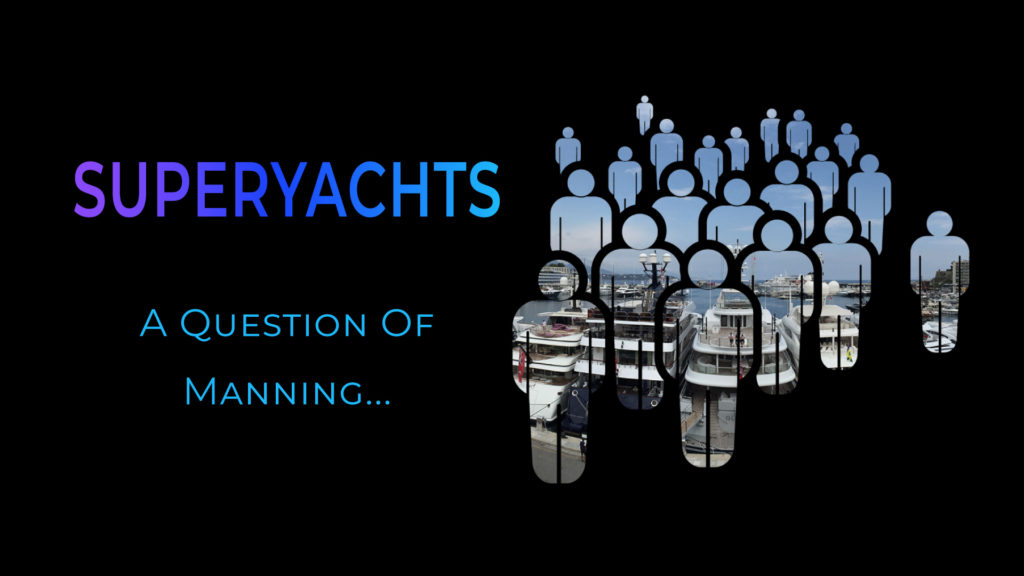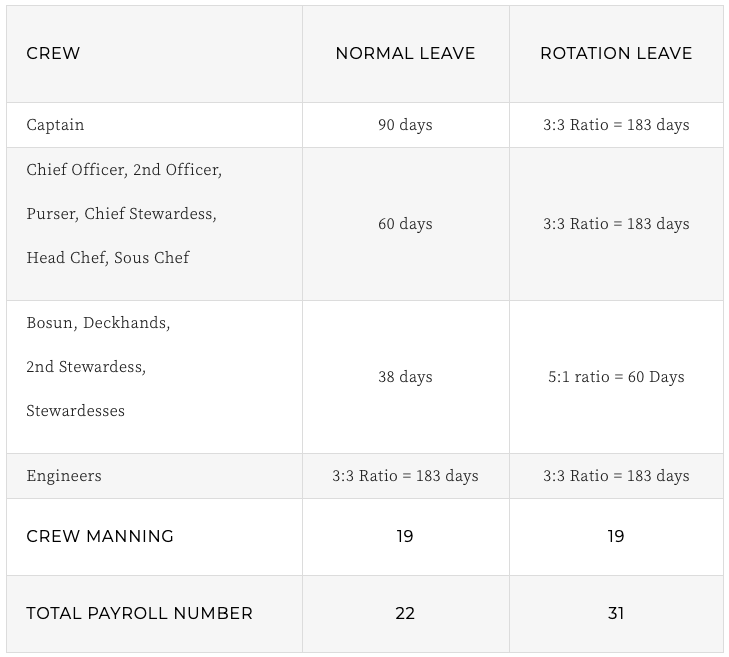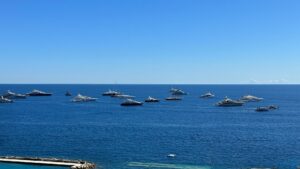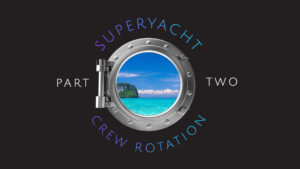Following on from the Superyacht Report article on manning, this is an extended piece that looks a little deeper at the issue.
Background
When I was asked to write the piece on Minimum Safe Manning (MSM) and how it affects yacht operations, I knew that, although an important factor, it was only one of a number of considerations used to determine the crew complement. However, what was also clear, is that many yachts do not have sufficient crew to meet the expectations and demands of their owners and guests. A point that was recently expressed in article from the International Superyacht Society (ISS) Captains Committee, where they raised concerns about fatigue and its dangers, and asked:
“why is it that manning levels that were appropriate years ago are still accepted as the norm today?”
From my own experience I can empathise with this.
Some time ago I took command of a yacht owned by a lovely family with a large family residence serviced by what seemed like an inexhaustible number of staff. For them, they were used to having the most attentive service 24 hours a day and had the same expectation for the yacht. They built a beautiful yacht that could carry up to 22 passengers which, she often did, but unfortunately was manned with the same number of crew as an equivalent 12 passenger yacht. As might be expected, it created significant challenges!
Following that experience, I also had the opportunity to review three new build PYC yachts and their manning. My observation on all of them, was that there was insufficient crew, partly because PYC compared to LY3 required additional MSM numbers, which impacted on the hotel side, but also due to the number of guests carried and services expected. After delivery, two ended up building more crew cabins – imagine the expense – and one downgraded to LY3 because they could not meet the MSM requirements without negatively impacting on the interior service. Clearly, if it was so obvious to an experienced mariner, why was it not obvious to the broker, designers and the shipyard?
The suitable manning of yachts is not restricted to large yachts either; there has been numerous discussions and articles written about crew on various sizes of yacht having to be ‘creative’ with their hours of work and rest in order meet owner/guest demands and remain compliant.
I suspect that many readers who have worked on busy yachts will have all had the same experience, where the team spirit, professionalism and commitment of the officers and crew to deliver the very best experience, overrides concerns about fatigue and the effect on performance, welfare, mental health, safety and crew retention.
So how are manning levels determined and, how can they be better understood?
Considerations
Along with the MSM (more of which below) there are other factors that normally determines the size and makeup of crew:
- Finance is an important consideration as crew expenses are amongst the highest operational costs so obviously it makes sense to optimise manning
- Manning levels on similar sized yachts are used as a comparable standard, especially applicable to production yachts
- Given the high value of the yachts ‘real-estate’ owners, understandably, will want to maximise owner/guest accommodation – the luxury spaces
- Technical, service, access and operational spaces also require a large volume
Additionally, some in the industry may be keen to gloss over crew numbers to help with a sale, they may fail to manage the owners expectations or, just do not possess the operational experience to understand the numbers needed for a particular owner and yachts operation.
Once the above factors are considered and the various spaces assigned, the crew accommodation is designed following the Maritime Labor Convention (MLC) guidelines and the number of cabins/berths can be defined. Interestingly, MLC may actually be having some unintended consequences; as one respondent – maybe controversially? – in the ISS article suggested:
“what we need is more berths not more space!”
Minimum Safe Manning
A commercial yacht will require a Flag state approved MSM – many private yachts, as with other regulations, may also choose to comply on a voluntary basis.
An owner/operator will make an MSM application based on Flag guidance and the IMO Principles of Safe Manning Resolution A.1047(27). Once approved, an Administration will issue an MSM certificate, however, this is only the minimum number of crew (those requiring STCW or equivalent qualifications). This is the captain, deck/engineering officers and ratings and, cook, depending on crew numbers and Flag requirements, necessary to safely operate a yacht when it proceeds to sea:
“The ship named in this document is considered to be safely manned if, when it proceeds to sea, it carries no less than the numbers grades/capacities of personnel specified in the table”
This does not include the hotel team; service, housekeeping, laundry and galley, or the additional deckhands necessary to launch tenders, run the water sports, etc., or other specialists required these days – these are all additional to the MSM.
A point of note is that the A.1047(27) changed from previous resolutions as follows:
A.890(21) and amendment A.955(23)
1.1.1 maintain safe navigational, engineering and radio watches in accordance with regulation VIII/2 of the 1978 STCW Convention, as amended, and also maintain general surveillance of the ship;
A.1047(27)
1.1 maintain safe navigational, port, engineering and radio watches in accordance with regulation VIII/2 of the 1978 STCW Convention, as amended, and also maintain general surveillance of the ship;
As you can see, safe manning in port was added but, so far, I have not seen any yacht specific guidelines on ‘port’ safe manning – commercial ships are normally involved in cargo operations so they tend to be more fully manned in port. In-port-manning can be a difficult issue for captains; it is often left to them to determine and they have to strike a fine balance between safely manning the yacht and providing crew valuable shore leave but, given number of incidents and fires in port, perhaps it should be better regulated? Running drills with reduced crew will help identify what is a safe number.
Often the Manning Scales provided by an Administration will be used as the standard. However, they allow some latitude on numbers based on the strength of the application and, operators can also take advantage of manning reductions allowed due to ‘distance from safe haven’ – which, for yachts, seems contrary to their operational demands?
So, once the MSM has been agreed the rest of the crew can be determined – if the total number of berths is 15 and the MSM is 8, that leaves 7 berths for the rest of the team.
Three Hundred and Sixty Degree Approach
As you might expect, this approach will produce mixed results – a bit like the ‘off-the-shelf’ budget that so often disappoints.
What is necessary a three hundred and sixty degree approach; an in-depth assessment of all the factors and how each unique owner wants to use their yacht. Only once armed with that information can you estimate the right manning levels and/or manage expectations by modelling the expected demands, peaks and crew work schedules.
The point of managing an owners expectations is key, especially in the case of production and semi-production yachts where crew accommodation/berths tend to be fixed. In these circumstances it is still important to make the assessment. This helps avoids frustration and disappointment by communicating any limitations that may surface, along with possible solutions, such as use of external laundry services, shore-based crew, or shadow boat, at the earliest stage to an owner.
“yes, the yacht can operate with these crew numbers but, the service onboard will be limited in these areas…is that what you want?”
Making a proper assessment requires effort and collaboration; asking questions, getting to know an owner, how they expect to use the yacht and the style and depth of services that are important to them.
Similar sized yachts with two very different owners (A) was a new build commissioned by a very experienced owner, and (B) an existing yacht purchased by an inexperienced owner.
On both (A) and (B) the normal crew complement was 19. The manning on (A) worked well, but on (B) we were unable to deliver and maintain the standards of service expected and without being non-compliant. Fortunately, the owner was understanding and pragmatic and, after detailing the issues and possible solutions, it was agreed that we would use two guest cabins for 4additional crew that allowed us to provide the level of service that was important to him. Later, the the yacht was modified and 2 additional crew cabins (4 berths) were added at considerable expense.
Understanding use and gathering information similar to the above example will help to determine the appropriate manning levels, especially during those important peak times in guest operation, and allow you to develop work schedules for all crew and each department. It may need several iterations and some finessing to get right but this is a crucial exercise as it provides the information necessary to have a meaningful discussion about manning with an owner.
Operational vs. Standby
Unlike a commercial ships where workload and manning is more easily determined and manage accordingly, yachts are a much more difficult and, not just because of different owners demands and expectations but also the seasonality and operational profile.
Many yachts, apart from shipyard periods, operate all year round, on standby for visits at the drop of a hat. These tend to be larger yachts and so full manning required can more easily be justified.
Smaller, or one season yachts, are a more complex situation. Whilst it might be essential to have 19 crew during the season, it may be difficult to justify that number sitting in port for the winter with no guest movements where a more appropriate number might be 12 i.e. sufficient to safely man and maintain the yacht in good order. And, if that choice was made, at least you have the berths necessary to increase crew for the season; though it should be noted it is easy to downsize a crew but, much more difficult to upscale again and expect the same quality of crew, personalisation, level of service, operation and safety standards.
Importantly, manning levels should be determined by the peak periods of operation; after all, that is when an owner or charter guest gets to experience the depth and quality of service.
Superyachts Today
In my time I have seen the whole industry evolve and so many positive changes have taken place.
Today, yachts are better built, more reliable, safer, officers and crew better qualified and trained, employment conditions improved, and there is now much better support available from yacht management and other shore-based service providers. At the same time, there has also been an incremental increase in owners expectations – some examples below: –
- Yachts and guests now rely heavily on electrical/electronic and AV/IT systems
- Beach clubs’ add another deck to be servced
- SPA therapists, hairdressers, gym instructors, nurses, nannies, are now routinely carried – are they single or dual role? Whatever the case, it generally means service and housekeeping are stretched as they lose a member to other activities
- Every night is ‘theme night’ with new table decorations and service expectations
- Photograph/video guest experience and provide a personal record for guests to go home with
- Flight crew, security and owners staff can add to numbers carried and place their own demands on crew
- Tenders are bigger, requiring more crew to launch and operate
- More toys carried like inflatable slides -heavy and labour intensive to setup/breakdown, especially when wet! – an ever-expanding list of toys, diving equipment, motorcycles, etc. – all require crew and maintenance
- Diving, Pilates, jetski, sailing, windsurf, kite surf…an almost endless list of activities
- Accommodation for river or ice pilots for yachts traveling further afield
These are further compounded by an increase in paperwork that is a fact of modern yachting e.g. budgets, purchase and approvals, crew HR functions, maintenance and refit planning, safety management systems, and management reporting – this generally falls on the shoulders of the captain and senior crew. One study on a 100m+ showed that the captain was spending 33% his time on their management companies demands which, along with their normal duties and responsibilities, was clearly unsustainable.
So, whilst there has been some positive changes in the industry that should be celebrated, the evidence suggests that manning levels maybe one element that has not profited from the evolutionary process.
Perhaps yacht crew are partly to blame for this due to yachting culture, as already posited, where they will work all hours necessary to deliver the very best experience for owners and guests, and often do so without complaint or communicating the problem outside of the yachts team. And, apart from this cultural norm, there are also undeniable concerns about job security where captains and crew may be reluctant to speak-up and/or report their hours of work and rest accurately for fear of losing their job. However, it is important as proper reporting helps to educate owners and the wider industry. Furthermore, if there was an incident and an inquiry, if falsification of hours of work were discovered and fatigue the root cause or contributing factor, it could have serious consequences for the crew, especially the captain.
Conclusion
The quality of captain, officers and crew and, the onboard experience is, without doubt, key to the success of a superyacht and this can only be achieved with the right manning levels which, unfortunately, have not kept pace with the advances made in the rest of the industry.
As the ISS piece stated ‘for the love of yachting’ we need to have an honest conversation about manning that includes owners and all industry stakeholders, especially those with operational experience. Getting this right improves the health and well-being of the crew, their performance, retention, yacht safety and, ultimately, leads to a better ownership experience.










